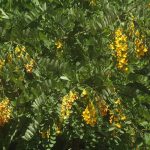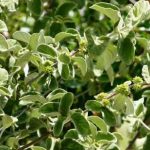TREE LIFE
February 2005
PROPOSED TREE SOCIETY VISIT TO NYANGA. Friday 11th Feb to Sunday 13th or Monday 14th. If you are interested, accommodation will be arranged, but it is vital to know exact numbers. This will be a self-catering week-end.
If you wish to be part of this group please email Maureen Silva-Jones by return email – giving your contact phone number, or phone her on 757171 at work or 740479 at home before Thursday 3rd Feb, that is this Thursday.
MASHONALAND CALENDAR
Tuesday 1st February. Botanic Garden Walk. Meet Tom in the car park at 4.45 for 5 pm.
Subject ‘the jesse.’
Sunday 20th February. A return visit to the popular Thetford Estate at Christon Bank.
We will meet at 9.30 am . Bring your lunch, water etc. for an all day outing.
Saturday 26th February. Mark’s walk this month will be a return visit to Mick Fleet’s property in Glen Lorne/Umwinsidale area where we will meet at the homestead at 2.30pm.
Tuesday 1st March. Botanic Garden Walk.
Easter Weekend. Arrangements have been made to visit Besna Kobila in the Matopos area. This is a large property with rivers, dams, vleis, kopjes and an enormous variety of plants.
It will be a self-catering week-end. Accommodation is in restored stables. There are showers, loos and a kitchen. Crockery, cutlery, gas plate, ice box etc. need to be brought with you. There is no electricity, but candles and wood will be provided. There are a limited number of beds, with bedding, mattress without bedding and ample space for camping.
The charges are:-
• camping $40000 per person per night,
• mattresses $60000 per person per night
• beds with bedding $80000 per person per night.
Please contact Maureen Silva-Jones
(H. 740479 or O. 757171) if you are interested and need more information and directions.
This will be our second visit to Besna Kobila and is highly recommended.
MATABELELAND CALENDAR.
Please phone J P Felu on Bulawayo 232797 or Jonathan Timberlake on 286529 for details of the next Matabeleland function.
CHRISTMAS SOCIAL: 5TH DECEMBER 2004
The Society’s annual Christmas Social took place at the Education Centre at the National Botanic Gardens on the first Sunday in December. We are very grateful to Miss Nobanda, the Head of the Gardens, for allowing us free entry to the Gardens and the free use of this facility.
We had a good turn out of members (over 35). After opening with tea, a presentation of small gifts was made to various members of the Society. Of the many people who have contributed, I would like to mention two in particular. Firstly, Vida Siebert, who has been a member of the Society for a long time, and who was for many years on the Committee and has done much hard work behind the scenes. She is now emigrating to the UK and we wish her well for the future.
Secondly, Tom, who has once again, led us so willingly on his monthly walks throughout the year. I’m sure it must on occasions be a bit tiresome to have to turn out to lead us (especially when we don’t make double figures). However, despite this, Tom has continued to lead us and has maintained his sense of humour. We thank him very much for his efforts.
After the presentations, Meg Coates Palgrave led the members on a walk in the gardens entitled “Christmas Trees”. This is written up separately.
The next item on the agenda was a quiz, which had been created by Adele Hamilton Ritchie and Rob Burrett. We divided into 5 teams and the questions were asked by Rob. I must say that I found the questions to be quite daunting. The quiz was good fun and Rob and Adele did an excellent job.
A long and leisurely lunch then followed and we, the organisers, were the last to leave at about 4 p.m. I felt it was a very successful event. It was very nice to meet members again in a relaxed environment for the last Tree Society event of 2004.
–Mark Hyde
CHRISTMAS TREES
The essence of the walk, kindly led by Meg, was to illustrate various aspects of the conventional “Christmas Tree” using examples from the trees in the Botanic Gardens.
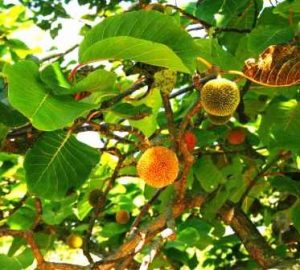
Burttdavya nyasica. Photo: Bart Wursten. Source: Flora of Zimbabwe
Firstly the shape of the tree. What makes a good Christmas Tree shape? I would suppose the conical shape with level branches from which one can hang baubles. Burttdavya nyasica (a Malawian tree) has a good shape of the right sort and even possesses its own baubles – pendulous spherical fruits!
Another tree or climber which has its own baubles is Combretum microphyllum. The baubles are again the fruits – in this case the well known 4 or 5 winged fruits which dry so well.
As an aside, often on our outings I have seen people fill their hats with Combretum zeyheri fruits. These are, of course, the largest combretum fruits we have and they dry exceptionally well and can be painted in various colours and/or covered in glitter.
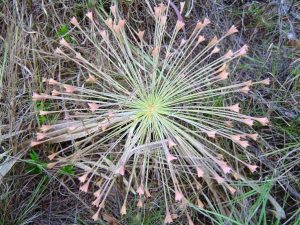
Boophone disticha. Photo: Bart Wursten. Source: Flora of Zimbabwe
Similar things are done with the extraordinary dry “tumble weed” inflorescence of Boophone disticha.
Terminalia stuhlmannii, Meg reported, was actually used as a Christmas tree in Kariba. This has strongly zigzag stems. Meg noted that this species has its spur branches all on top of the branches whereas in Terminalia prunioides, the spur branches are all around the branches.
[Another interesting observation concerned the Msasa pods lying all around on the ground. In the moist atmosphere of that day they were lying flat on the ground. However, Meg pointed out that when they dry out they will curl up – and then straighten out again when wet, sometimes repeatedly]On to Ilex mitis, the African holly. This belongs to the same genus as the European holly, Ilex aquifolium (and as Candace pointed out an American one – Ilex americana).
Meg mentioned that:
‘Ilex is an old Roman name, now used as the generic name for holly, while “holm” is an old English name for holly, now transferred to the “holm oak”, Quercus ilex. The name “holm” probably comes from the Anglo Saxon “holegn” meaning the “holy tree”. This was so called when the tradition of decorating houses with it in winter, apparently associated with the Roman festival of Saturnalia was taken over by Christians for Christmas.
Our African holly, Ilex mitis, also produces red berries but only female trees can do this, and only when there is a little boy tree in the vicinity.
Our final tree was Widdringtonia nodiflora, an indigenous cypress, occurring in the E Highlands. This is certainly more closely related to the traditional Christmas trees of Europe which tend to be conifers of one sort or another.
Finally, I must apologise to Meg if I have omitted or misrepresented anything she said. I was a bit tied up with the arrangements and was not always close enough to hear what was being said.
A very big thank you to Meg for a very informative and entertaining walk.
-Mark Hyde
BOTANIC GARDEN WALK 7th DECEMBER 2004
It was only two days after a most successful Christmas function that the Tree Society met again in the Botanic Gardens. The weather was warm and overcast, but fortunately we did not have to use our umbrellas. None of the usual walk leaders were available to guide and educate the party. Instead, twelve members and friends enjoyed an evening stroll among the trees, stopping to admire any specimen that caught our eye. Maureen obliged with identifications if we were stuck.
The most eye-catching feature was size; not being a regular visitor to the gardens, I had not realised how large the trees had grown since the gardens were established. I remember how I used to school my pony many years before in the same area, when the only trees were musasas. Pride of place for size went to a Ficus chirindensis growing on the edge of the rain forest section. It was not the height but the extent of the canopy that impressed; 18 m from the trunk to the edge of the canopy, with the branches spreading horizontally a metre or so above the ground. The leaves were a beautiful glossy green, providing dense shade over the grass underneath. Almost rivaling it for spread was the Ficus verruculosa growing by the pond near the car park. However, its branches rested on the ground, and the canopy was much less dense.
For height, it was difficult to choose between Newtonia buchananii and Albizia gummifera. They are both high altitude rain forest species and were sited in groups on the margins of the rain forest section. Albizia gummifera is a popular tree for Harare gardeners, but has an unfortunate tendency to split. A grove of tall Albizia amara in the parkland near the herbarium was also impressive. Finally in this category was a very large Ficus sycomorus, with massive, yellow-barked branches, standing by itself.
Other trees attracted attention for a variety of reasons. Early in the walk we encountered a group of Tamarindus indica.
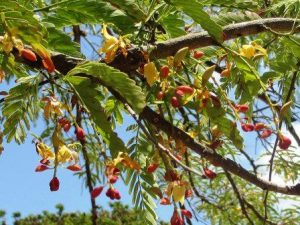
Tamarindus indica. Photo: T. Rulkens. Source: Flora of Zimbabwe
We had learned during Sunday’s quiz that the tree is also known as the Indian Date, which seems a very inappropriate name, as the tree bears no resemblance to a date palm. The reason is to be found in Meg’s book. The trees were known in Egypt four centuries before the birth of Christ and may have been introduced by early Arab and Persian merchants to India. There they are now widely planted, particularly along streets. The dark brown pulp made from the fruit resembles dried dates, from which the name Tamarehindi (Indian date) was derived, and subsequently the scientific name Tamarindus. In Zimbabwe the species is established only along the Zambezi River, but whether it is indigenous or was introduced by Arab traders who used the course of the river as a route into the interior is not known. The trees in the gardens are not as tall as along the Zambezi, not surprisingly. One of them was in flower and was most attractive, with small red buds opening into cream orchid-like blooms along the upper surface of the branches.
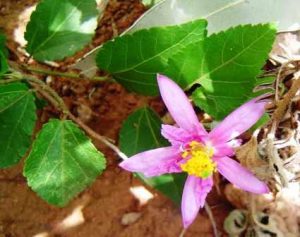
Grewia occidentalis. Photo:Bart Wursten. Source: Flora of Zimbabwe
Other trees in flower that caught our eye included Grewia occidentalis, an Eastern Districts species which is present in an enormous thicket, presumably of more than one bush, that was covered with mauve, star-like blooms. The impressive Anthocleista grandiflora, which stands out above the forest in the Honde Valley and is easily recognised by its enormous leaves, grows in a small grove in the Gardens and was just beginning to produce large, cream-coloured tubular flowers. Opinion was divided amongst the party as to whether their scent was pleasant or not. Friesodielsia obovata, a species that we sometimes encounter near Harare, bore characteristic buds that were cylindrical and upright and were enclosed by three sepals.
Common names to identify trees are frowned on by the Tree Society, because they are imprecise, and the same name is often used for many different species. Mahogany is a good example. However, some of them are very appropriate and well worth remembering. For instance, I don’t think I will forget the Pawnbroker-tree, which is a lowveld species and has bladder-like fruit containing three large round seeds that resemble the signs above pawnbrokers’ shops in England. Its scientific name, Excoecaria bussei, is unlikely to stick. The Sandpaper Figs, Ficus capreifolia and F. exasperata, are also most appropriately named, because the leaves are so rough that they can be used as a substitute for sandpaper. I’m not so impressed with the common name for Cordyla africana, Wild-mango. The only feature that is similar to the ordinary mango is the colour of the fruit. The tree doesn’t look like a mango tree, and the fruit neither look nor taste like mangos. In fact, in Malawi, the fruit used to litter the ground under the trees, because nothing and nobody ate them. So perhaps the Society is right to ignore these names.
As tree lovers, we owe a great deal to Tom Muller for planning and establishing the Botanic Gardens. Tom’s vision and hard work have now made it possible for us to visit a wide variety of botanic ecosystems without leaving Harare. Thank you Tom.
-J.A.Lawrence
Greetings from the Haxens in Australia.
Next month we hope to print Phil’s letter updating us on the family news, but in the meantime here is the write-up which Phil did of a trip with the Toowoomba Field Naturalists group of which he and Cheryl are members.
Binna Burra, Lamington National Park- Sunday 21st November 04
On Sunday 21st November, 04, we joined Bill McDonald, whose day job is as a botanist with the Mt Coot-tha Botanic Garden/Herbarium in Brisbane on a walk which took us to the Tullawallal “lookout”. Along the way there and back we encountered a considerable variety of fauna and flora. I was pestering Bill for plant names, so I need to be forgiven if this account is a little slanted in the flora direction. Nonetheless, I was most impressed with the Tiger leeches which Bill pointed out on the trunks of the saplings we were passing, as they stretched out their bodies into thin waving “worms” as we passed by, attracted apparently by the heat of our bodies. The “tiger” refers to the bright yellow longitudinal stripes down their bodies which contrast vividly with the dark chocolate brown of the background. Rather pretty really! On the day before we had the experience of becoming leech dinners on the walk back through the rain. We were introduced to the local pademelons; various birds including the Rufous Fantail and the Paradise Riflebird. We also learned that the Cowbird calls in duet fashion – “Where are you?” -“I are here!”
Writing this now from memory and a few scribbled notes, there were a few trees and shrubs which made an impression. There was Triunia youngiana, the Spice bush a member of the Proteaceae family, which is remarkable for its exceptional toxicity in all parts of the plant. Still, it has the most pretty little white composite flower. We met with Baloghia inophylla, the Scrub bloodwood, of the Euphorbiaceae which does indeed ‘bleed’ a red sap when a leaf is pulled from the stem. We then had the pleasure of meeting up again with a Finger lime Citrus australasica (Rutaceae). The last time we had encountered this was at Wee-Walk native foods nursery near Mt Walker, where this plant was being commercially grown on grafted stocks to produce fruit for the gourmet restaurant trade. Now here it was growing naturally in the rain-forest!
We were treated to the sight of the native gardenia, Randia benthamiana (Rubiaceae), in flower. The small white flower had the sweet fragrance typical of gardenias, whilst the opposite leaves bore the interpetiolar stipules on the stem which is a diagnostic feature of the family Rubiaceae of which Randia is a member. Although the leaves are generally regarded as being opposite, more often than not they come out in whorls of three, which is something common in the gardenias. Bill showed us Premna lignum-vitae, Lignum-vitae (Verbenceae), which has a timber which is so hard and dense that in days past it was used to make bearings for the propeller shafts for steamships! We met with several Ficus watkinsiana, the Watkins/strangler fig (Moraceae), many of which had so entwined their roots about their host trees that the host had long since died and rotted away leaving a hollow pipe towering into the forest canopy with large buttresses at the base.
Two palms (Arecaceae) were represented – Linospadix monostachya, the Walking-stick palm, a small understorey palm which will yield a tough stick suitable as a perambulatory aid, and Archontophoenix cunninghamiana, the much larger and taller Bangalow palm which can make it to the forest canopy.
The only tree with bi-pinnately compound leaves which we encountered was the forest pioneer Polyscias elegans, the Celerywood which belongs in the Araliaceae family.
It is always most impressive to walk through the forest with Bill as he identifies many of the forest giants simply from their bark. Premna lignum-vitae is an example, as were Argyrodendron actinophyllum, the Black booyong (Sterculiaceae), Argyrodendron trifoliolatum, the White booyong, Duboisia myoporoides, the Corkwood (Solanaceae), and Ceratopetalum apetalum, Coachwood (Cunoniaceae). One which even I could identify was Zanthoxylum brachycanthum, the Thorny Yellowwood (Rubiaceae), which bears its hooked prickles on woody bosses running up the trunk of what is really more of a liana than a tree. It is very similar to Zanthoxylum capensis with which I became quite familiar in Southern Africa.
Several of the trees were really only identified as a result of their ‘droppings’ on the ground. In the case of Brachychiton acerifolius, the Flame tree (Sterculiaceae), it was the fallen brilliant red flowers. In the case of Syzygium crebrinerve, Purple cherry (Myrtaceae), and Syzygium corynanthum, sour cherry, it was the give-away Lilly-pilly fruit. Bill was happy to find the dropped fruit of Pouteria australis, Blue apple, for propagation purposes.
During the afternoon we met with Sloanea australis, a medium-sized tree being a member of the family Elaeocarpaceae which rejoices in the common name of Maiden’s blush. This is apparently because the new leaves flush a reddish colour, even though the mature leaves are dark green. Also in same genus was Sloanea woollsii, the Yellow carabeen. This is a large tree which develops the so-called ‘plank-buttresses’. I did not get what is yellow about it, but I assume the leaves turn yellow before falling. One might expect the Red carabeen, Geissois benthamii, to be another close relation, but not only is it in a different genus, but it also belongs in a different family, the Cunoniaceae. Apparently, this tree also develops heavy buttresses as does the third member of the family which we saw, Pseudoweinmannia lachnocarpa, the Rose Marara.
Many thanks to Bill McDonald for an instructive afternoon and for his endless patience when difficult scientific names won’t stick in the brain!
-Phil Haxen
THE PETHERAM FILES Continued…..
Our Ancient Past
This file was labelled Palaeontology, but the bulk of the material was concerned more specifically with palaeobotany. There were cuttings from several newspapers and journals, as well as notes that Dick Petheram had written himself. Some of his notes were handwritten, and others were typed, suggesting that they had been prepared for an address, or perhaps an informal talk. Dates on his own notes and on the cuttings show that this file was put together between 1975 and 1983. The editing of this material for TREE LIFE has largely been confined to updating place names.
Fossilized Rhino Head
Below is the draft of a letter dated 4/3/75 written by Dick Petheram to Mike Raath, at that time Director of National Museums and Monuments:
On page 3 of his “Medieval Rhodesia” (1971 New Impression published by Frank Cass & Co.), D Randall-MacIver records his indebtedness to Mr EM Andrews, who showed him the stone ruins near Mutare, and the soapstone carvings found there.
It is this Edward M Andrews who, in a letter to Sir Lewis Michell in Cape Town, dated (from Mutare) 15th February 1905, wrote, inter alia:
“Some two years ago, whilst shooting between the Pungwe River and the Nyanga Mountains, really in M’kombi’s country, I came upon a very fine specimen of a fossilized rhino head. Being short of boys, I could not bring it along. I buried it, but think I could find it again. Would such a thing be of any use to a Museum?”
The letter in the main (copy contained in Archives File DT 2/8/11) deals with Randall-MacIver’s impending visit to the country, and EM Andrews’ offer to clean up the grass and bush round the (Mutare) ruins, and to guide Randall-MacIver to them. It was because of this offer that EM Andrews’ letter, on Sir Lewis Michell’s instructions, was copied to R Myburgh, Magistrate, Mutare, by B Woods, Secretary, Rhodes Estate, Rhodes Building, Cape Town, and subsequent correspondence in the file deals only with the grass and bush clearing and the cost thereof. Nothing more—to my great regret—on the intriguing matter of the fossilized rhino head.
In further correspondence between Woods and Myburgh, Randall-MacIver is said to have been “much impressed with the ruins at Mutare”.
The only published work by EM Andrews that I’ve been able to locate is a paper on the Webster Ruins, 100 km south from Chimanimani (Rhodesia Scientific Association Proceedings, Vol VII, 1907, Part I, pp 62-71). Again, no fossilized rhino heads!
My wife and I are making some enquiries in the hope of tracing descendants of Mr EM Andrews, and serving this rhino morsel up to you on a plate. But the Mutare Museum authorities (who presumably have Andrews’ Mutare soapstone carvings, etc. might be the shortest cut to an historic discovery.
On a unique door-stop,
Yours sincerely (etc).
Fossils and Extinct (or not so extinct) Tree Genera
The material under this heading is an edited composite of Dick Petheram’s hand-written notes in File 3 and typed notes from File 1. Included in this composite is some material from Professor Geoffrey Bond’s The Palaeontology of Rhodesia, published in 1973 in Bulletin No 70, Rhodesia Geological Survey.
From the rock and soil formations that make up Zimbabwe’s Karroo System (so named because of its similarity to one of the main geological systems in South Africa), a small treasure trove of plant fossil remains has been extracted. The material ranges from carbonized impressions to silicified logs.
Broadly speaking, the Karroo System covers the Upper Carboniferous, Permian, Triassic, and Jurassic periods, from about 350 million to 180 million years ago. During this time the country was subjected to changes as extreme as glaciation on the one hand and volcanic activity on the other, and also to climatic change attendant upon movement through continental drift.
The findings of palaeontologists and others indicate that the woody plants of the earliest soil formations of the system were those that are described in general terms as the Glossopteris flora. The terminology is used in the same way as we, today, use expressions such as “brachystegia woodlands”, not to imply woodland that is composed exclusively of the genus Brachystegia, but to indicate its predominance, together with trees frequently associated with it. There were, in fact, several other ancient genera, prominent among them Gangamopteris and Cordaites, as well as several different species of Glossopteris.
Glossopteridae have been described by Plumstead (1958) as quoted by Bond (1973) as mainly deciduous woody plants of an arborescent habit [on which] leaves flowers and fruits grew as short shoots at fairly wide intervals from a woody stem, and also terminally.
Fossil fragments of the trees of this period have been identified in the Pebbly Arkose Formation of the Upper Karroo succession from about 20 localities in the Binga, Bubi, Bulawayo, Chilimanzi, Gokwe, Guruve, Gweru, Hwange, Kariba, Lower Gweru, Nyamandhlovu, and Sebungwe districts, and also from the Limpopo basin.
As time went on, Gangamopteris and other closely allied genera vanished from the scene. Glossopteris (as evidenced by fossil remains from the Sebungwe, Gokwe, Binga, and Hwange districts) continued to grow, but, over many millennia, lost their vigour due to environmental changes; and at this period of time swamp reeds became abundant.
With the further passing of time merging into the Triassic period—about 230 million years ago—the coniferous genus Dadoxylon became dominant, associated with genera such as Rhexoxylon, and it is Dadoxylon that today represents, visually, the most dramatic evidence we have of our ancient tree life.
There is a particularly fine specimen in the Lupane District, about 17 m long (in nine pieces), and I used to know of another, almost as big, lying in a remote part of Hwange National Park, among hundreds of smaller fragments. I hope it is still there. [Comment 2002: The late Professor Geoffrey Bond, well known in geological circles in Zimbabwe for many years, found a fossil log in the Detema area of Hwange National Park that was 120 cm thick at the base, at least 18 m long, and still 30 cm in diameter at the top end. This log does not appear to have been found again by anyone at the Park. Bond (1973), The Palaeontology of Rhodesia, recorded that plant fossils of four species have been found in the Pebbly Arkose Formation; these are Dadoxylon bondii, Rhexoxylon africanum, Rhexoxylon tetrapteroides, and Mesembrioxylon gwavense.
In several parts of Zimbabwe, notably in the Zambezi Valley, lie the fossilized remains of these conifers, now so completely exposed through erosion processes that it is possible in places to gauge their probable living height by pacing the length of the less fragmented among them in their fallen state, and to marvel at the faithfulness and clarity with which bark features and growth rings seem, in some cases, to have been preserved.
Fossilization occurs through a process in which plant tissues are replaced, cell by cell, by silica. This is generally agreed, but there is a lot of theorizing about how it happens.
Silica constitutes over 50 percent of the earth’s crust, and chemical analysis shows that it also constitutes between 30 and 70 percent of the ash of wood and vegetable matter. Under normal (neutral) conditions silica is insoluble in water. However, in extremely saline (alkaline) conditions silica can become suspended in water, with other minerals. If, in such circumstances, there occurs a sudden drop in the pH level (i.e. from extremely alkaline towards neutral), the suspended silica is precipitated to form a solid mass.
For fossilization to occur, trees must be submerged in a medium that continues to collect sediment, and also in or near water, for example, in a lake in an arid area, with high prevailing temperatures and very saline water. In these conditions a sudden change of pH (e.g. from rapid flooding by fresh water) could cause precipitation of silica compounds within submerged trees—and hence fossilization.
The sort of cataclysm that brought about this process millions of years ago (if, indeed, it was a cataclysmic change) can only be imagined. It seems theoretically possible that trees became submerged in lake conditions, perhaps in basins between mountain ranges, in highly saline water, and were subjected to sudden flooding by fresh water, or a period of torrential rains, thus creating an abrupt change in pH, which led to the precipitation of the silica compounds within them, and to their preservation thereafter in fossilized form.
Our fossil forests (e.g. near Hwange and in the Dande Communal Lands) were formed in the Triassic period from Arkose sediments, and are probably over 200 million years old. However, records from Australia mention fossilized wood with modern 6-inch nails in it, indicating that the fossilization process can occur extremely rapidly, i.e. in a few seasons, given suitable conditions.
Dadoxylon is an extinct coniferous genus. But it might be unwise to bet on that! We recall that the supposedly extinct coelacanth, a primitive marine fish, made a startling reappearance off the eastern African coast in 1938. Furthermore, a living specimen of the deciduous conifer, Metasequoia glyptostroboides (dawn redwood, or water fir), previously known only from fossil remains, was discovered in central China in 1945. Not only that, but it was successfully propagated, and from cuttings imported from China by AC Soffe of Mutare, specimens were raised and planted in Zimbabwe. We have, therefore, a direct link, through an introduced species, between the present and the very ancient past.
But this is not the only one. There are distinct similarities, I learn from Mr Mike Raath, between the microscopic stem structure of the extinct Dadoxylon and that of the well-known monkey puzzle, Araucaria angustifolia introduced from Argentina and Brazil. These coniferous genera are not of the same botanical family, but the monkey puzzle is a living species of a genus that made its appearance more or less contemporaneously with Dadoxylon in the Upper Triassic period.
[Comment 2002: Living specimens of yet another supposedly extinct species, Wollemia nobilis, were discovered in New South Wales, Australia, in 1995. This tree belongs to the coniferous family Araucariaceae.]
Lyn Mullin To be continued.
URGENTLY REQUIRED.
Seeds or seedlings of Pericopsis angolensis (muwanga) and Pterocarpus rotundifolius (round-leaved blood wood) Please phone Judy Wienand on Hre 490802.
HISTORIC TREES OF ZIMBABWE
By LYN MULLIN.
Copies of this wonderful book are still available from Maureen Silva-Jones.
Telephone. Home 740479; Work 757171(Harare)
Prices:
Hard Cover – $150 000
Leather Bound – $200 000
MARK HYDE CHAIRMAN


